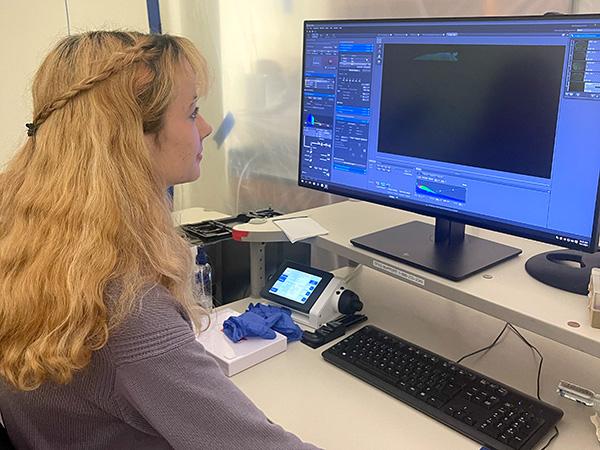Student Project Profile
Ketamine’s Role in Time Perception – Sophia
Project Title
Investigating the Role of (S)-Ketamine in Time Perception
Faculty Mentor(s)
Project Description

It is known that ketamine disrupts the time perception of healthy individuals. However, little is known about how ketamine modifies time perception, and how this may differentially affect females and males. We are investigating how ketamine may disrupt the perception of time on behavioral and neuronal levels in mice.
(S)-ketamine is a drug that has antidepressant properties and is currently used as a therapy for treatment-resistant depression. The goal of this project was to investigate the effects of (S)-ketamine on time perception using a mouse model. To do this, we measured behaviors associated with estimating time intervals using a test called the Serial Fixed Interval task in female and male mice. To determine how ketamine is modulating brain activity, we conducted gene expression assays in brain regions associated with timing. Our data suggest that ketamine alters timed behaviors and we anticipate finding that brain gene expression is affected by (S)-ketamine.
How long have you been conducting research?
I have been conducting research since my junior year of high school, where I had the opportunity to learn research skills at a lab at Seattle University. When I started college, I interned in a lab during the summer and winter terms at the Institute for Stem Cell and Regenerative Medicine at the University of Washington. I began research at Oberlin College in the Howard Lab the fall of my second year.
Why is your research important?
Ketamine is a valuable therapeutic tool and investigating its mechanism of action is key to understanding how it intervenes in treatment-resistant depression. My research is important as there are few studies which analyze potential sex differences of (S)-ketamine and I hope to explore this further. Specifically, I hope my research will broaden scientific and medical knowledge about how drugs affect female bodies.
What does the process of doing your research look like?
My research takes place in the lab, however, the work I do throughout this project varied a lot. At the beginning of the project, I ran mice on behavioral tasks in collaboration with other students in the lab. Toward the end of the project, I ran immunohistochemistry and took lots of microscope images.
How did you get involved in research? What drove you to seek out research experiences in college?
Going into college, I knew I was incredibly interested in neuroscience, loved research in the past, and wanted to be involved in learning and creating further knowledge in the field. In college, I was introduced to a member of the Howard Lab at the Oberlin Research Symposium and became interested in his work which led me to meet with Professor Howard.
What is your favorite aspect of the research process?
My favorite thing about my project is that it has multiple meaningful implications that I am incredibly passionate about. My project can work to combat sexism in neuroscience and medicine, in addition to characterizing the mechanisms of a commonly used drug. By not only including female rodents but by also completing sex-specific analyses, I hope to add to knowledge that characterizes the mechanisms of drugs on female bodies.
How has working with your mentor impacted the development of your research project? How has it impacted you as a researcher?
Working with my mentor has impacted the development of my research project because my mentor has supported my ideas and creativity in developing the project and throughout the project. I also have learned many new scientific techniques and research skills from my mentor, which have helped me grow as a researcher. Additionally, my mentor facilitates a positive and welcoming environment in the lab which has helped me to grow as a project leader in the lab.
What advice would you give to a younger student wanting to get involved in research in your field?
I would tell younger students wanting to get involved in research in my field to not be afraid to reach out to upperclassmen in your major or who are already in research to learn more. Most of the time, upperclassmen are happy to talk about their research, how they got into their lab, and are happy to help younger students in their research journeys.
This is a joint project with Sarah McDonald.
Students

Sophia Krikawa ’25
third-year- Major(s):
- Neuroscience, minor in Dance